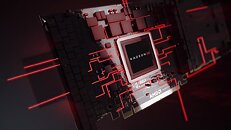Tuesday, August 11th 2020

AMD RDNA 2 "Big Navi" to Feature 12 GB and 16 GB VRAM Configurations
As we are getting close to the launch of RDNA 2 based GPUs, which are supposedly coming in September this year, the number of rumors is starting to increase. Today, a new rumor coming from the Chinese forum Chiphell is coming our way. A user called "wjm47196" known for providing rumors and all kinds of pieces of information has specified that AMD's RDNA 2 based "Big Navi" GPU will come in two configurations - 12 GB and 16 GB VRAM variants. Being that that is Navi 21 chip, which represents the top-end GPU, it is logical that AMD has put a higher amount of VRAM like 12 GB and 16 GB. It is possible that AMD could separate the two variants like NVIDIA has done with GeForce RTX 2080 Ti and Titan RTX, so the 16 GB variant is a bit faster, possibly featuring a higher number of streaming processors.
Sources:
TweakTown, via Chiphell

104 Comments on AMD RDNA 2 "Big Navi" to Feature 12 GB and 16 GB VRAM Configurations
More fuel to the fire is that the most popular product built on Samsung's 8nm is its own Exynos phone processors but Samsung's flagship Exynos 990 is inferior to the Qualcomm Snapdragons built on TSMC. It's not an apples-to-apples comparison because we're talking about two different ARM designs here as well as two different process nodes, but ARM cores are ARM cores so in like-for-like testing, the chip built on the best manufacturing process ought to clock higher, for longer and win. In every tested case, that victory does indeed go to TSMC's 7nm Snapdragon 865 chips, even when the test is between two otherwise identical Samsung S20 Ultra phones and running the same Samsung OS.
Tom from MLID is a pretty solid source. Here's a specific example that includes a lot of educated guesswork and industry-sourced info that builds a picture of Samsung's 8nm:
This video is a month old and some of the info from it (such as the 21Gb/s GDDR6, for example) was only confirmed by the rest of the press in this last week.